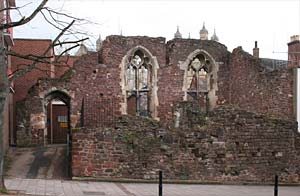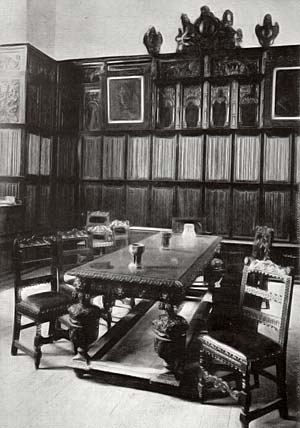
The Hall of the Vicar's Choral
Page added 6th April 2011
The ancient College of the Vicars Choral and related buildings was between South Street and Cathedral Yard. The College of the Vicars Choral were the subordinate clergy who sang at the daily services of the cathedral. The college was constructed between the years 1383 and 1388 by Bishop Brantingham.
The entrance was through an archway situated in Cathedral Yard to the south-west of the West Front of the Cathedral. The archway led into a narrow street known as Kalendarhay, named after the Kalendar Brethren who prepared the ecclesiastical calendar of obits – these were masses, normally held once a month for the souls of rich people who had died. A sum of money would be left in their will for such a purpose, and hence fund a job creation scheme for a whole cabal of priests. Henry IV in 1405 granted a charter to the Corporation of the Custos and College of the Vicars Choral.
On each side of Kalendarhay were small individual lodges for each member of the college, allowing close supervision by the cathedral authorities. The lodges were demolished in stages between 1850 and 1893. At the end of Kalendarhay was the Hall of the Vicar's Choral where the priests who resided in various houses and cottages around Cathedral Close, including those in Kalendarhay, would gather to meet and to eat. The Hall had a kitchen that was also used as an inn and which in the early nineteenth century was known as the College Kitchen, and later, the Bear Inn. The public water conduit in South Street was situated at the front of the Hall of the Vicars Choral
The Hall was one of Exeter's architectural gems, which attracted numerous visitors before the war. The walls were lined with sixteenth century linen fold panelling, and the furniture was of ornately carved oak dating from James I (VI of Scotland). A fireplace bearing the coat of arms of five bishops, dating from the early eighteenth century, was a gift from the Cathedral Treasurer.
The members of the Vicars Choral, during the nineteenth century, were responsible for selecting and appointing clergy in various parishes around Exeter, a task that was done through a vote of the members. They were also substantial land owners, deriving an income from tithes from Woodbury and land by the railway near Broadclyst. The Church of St Swithin, Woodbury was granted to 24 members of the College in 1205 by Bishop Marshall of Exeter who had acquired it from the Abbey of St Michael Normandy.
Around about 1865 the southern row of cottages in Kalendarhay were demolished, and in 1871 the northern row were taken down, along with the Bear Inn, leaving just the Hall. After St John's Hospital School was closed in July 1931, two of the famous Blue Boy statues from the school were displayed in the Hall of the Vicars Choral.
On 4 May 1942, the Hall received a direct hit and was destroyed, along with many of the other buildings at the top of South Street. As a remembrance of the dreadful night, the walls of the hall were preserved and can still be seen. The fireplace was salvaged from the ruins and moved to St Nicholas Priory, where it can be seen today. The Blue Boy statues were also salvaged and taken to Upton Pyne.
St George's Church stood on the west side of South Street, opposite the College until 1843, when it was demolished for road widening. After the destruction of South Street, a Saxon doorway from the church was uncovered. Just a scrap of wall and doorway, but one of the earliest, still surviving structures in Exeter. When it was decided to preserve the ruins of the Hall as a memorial to the bombing, St George's doorway was moved into the grassed area in front of the ruins, where it can be seen today.
Sources: Flying Post, Exeter Timetrail (RAMM website) and research for other histories on this website.
 The remains of the Hall of the
Vicar's Choral.
The remains of the Hall of the
Vicar's Choral.
 Interior of the Hall showing the
rich, oak lined walls and furniture.
Interior of the Hall showing the
rich, oak lined walls and furniture.
│ Top of Page │